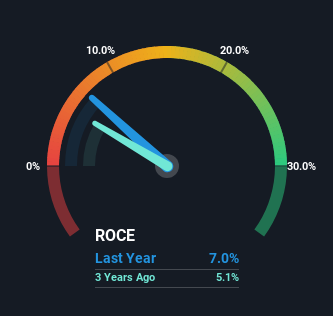Here's What's Concerning About Jiangsu Sunshine's (SHSE:600220) Returns On Capital

If you're looking at a mature business that's past the growth phase, what are some of the underlying trends that pop up? More often than not, we'll see a declining return on capital employed (ROCE) and a declining amount of capital employed. This combination can tell you that not only is the company investing less, it's earning less on what it does invest. In light of that, from a first glance at Jiangsu Sunshine (SHSE:600220), we've spotted some signs that it could be struggling, so let's investigate.
What Is Return On Capital Employed (ROCE)?
For those who don't know, ROCE is a measure of a company's yearly pre-tax profit (its return), relative to the capital employed in the business. The formula for this calculation on Jiangsu Sunshine is:
Return on Capital Employed = Earnings Before Interest and Tax (EBIT) ÷ (Total Assets - Current Liabilities)
0.07 = CN¥161m ÷ (CN¥4.3b - CN¥2.0b) (Based on the trailing twelve months to September 2023).
Therefore, Jiangsu Sunshine has an ROCE of 7.0%. In absolute terms, that's a low return but it's around the Luxury industry average of 5.9%.
View our latest analysis for Jiangsu Sunshine

Historical performance is a great place to start when researching a stock so above you can see the gauge for Jiangsu Sunshine's ROCE against it's prior returns. If you'd like to look at how Jiangsu Sunshine has performed in the past in other metrics, you can view this free graph of Jiangsu Sunshine's past earnings, revenue and cash flow.
What Does the ROCE Trend For Jiangsu Sunshine Tell Us?
We are a bit worried about the trend of returns on capital at Jiangsu Sunshine. To be more specific, the ROCE was 9.9% five years ago, but since then it has dropped noticeably. And on the capital employed front, the business is utilizing roughly the same amount of capital as it was back then. Since returns are falling and the business has the same amount of assets employed, this can suggest it's a mature business that hasn't had much growth in the last five years. If these trends continue, we wouldn't expect Jiangsu Sunshine to turn into a multi-bagger.
On a separate but related note, it's important to know that Jiangsu Sunshine has a current liabilities to total assets ratio of 47%, which we'd consider pretty high. This effectively means that suppliers (or short-term creditors) are funding a large portion of the business, so just be aware that this can introduce some elements of risk. While it's not necessarily a bad thing, it can be beneficial if this ratio is lower.
In Conclusion...
In the end, the trend of lower returns on the same amount of capital isn't typically an indication that we're looking at a growth stock. It should come as no surprise then that the stock has fallen 49% over the last five years, so it looks like investors are recognizing these changes. With underlying trends that aren't great in these areas, we'd consider looking elsewhere.
Jiangsu Sunshine does come with some risks though, we found 4 warning signs in our investment analysis, and 2 of those make us uncomfortable...
While Jiangsu Sunshine may not currently earn the highest returns, we've compiled a list of companies that currently earn more than 25% return on equity. Check out this free list here.
New: Manage All Your Stock Portfolios in One Place
We've created the ultimate portfolio companion for stock investors, and it's free.
• Connect an unlimited number of Portfolios and see your total in one currency
• Be alerted to new Warning Signs or Risks via email or mobile
• Track the Fair Value of your stocks
Have feedback on this article? Concerned about the content? Get in touch with us directly. Alternatively, email editorial-team (at) simplywallst.com.
This article by Simply Wall St is general in nature. We provide commentary based on historical data and analyst forecasts only using an unbiased methodology and our articles are not intended to be financial advice. It does not constitute a recommendation to buy or sell any stock, and does not take account of your objectives, or your financial situation. We aim to bring you long-term focused analysis driven by fundamental data. Note that our analysis may not factor in the latest price-sensitive company announcements or qualitative material. Simply Wall St has no position in any stocks mentioned.
About SHSE:600220
Jiangsu Sunshine
Engages in the wool textile and thermal power businesses in the People’s Republic of China and internationally.
Good value with adequate balance sheet.
Market Insights
Community Narratives




